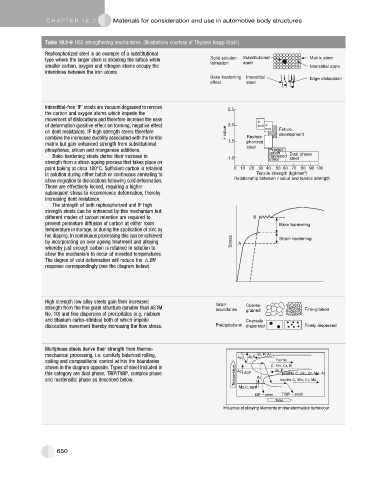Page 642 - Automotive Engineering Powertrain Chassis System and Vehicle Body
P. 642
CHAP TER 1 8. 2 Materials for consideration and use in automotive body structures
Table 18.2-9 HSS strengthening mechanisms. (Illustrations courtesy of Thyssen Krupp Stahl.)
Rephosphorized steel is an example of a substitutional
type where the larger atom is straining the lattice while Solid-solution Substitutional Matrix atom
formation atom
smaller carbon, oxygen and nitrogen atoms occupy the Interstitial atom
interstices between the iron atoms
Bake-hardening Interstitial Edge dislocation
effect atom
Interstitial-free ‘IF’ steels are vacuum degassed to remove 2.5
the carbon and oxygen atoms which impede the
movement of dislocations and therefore increase the ease IF
of deformation (positive effect on forming, negative effect steel IF
on dent resistance). IF high strength steels therefore value 2.0 HSS Future
development
combine the increased ductility associated with the ferritic r Rephos-
1.5 phorized
matrix but gain enhanced strength from substitutional
steel
phosphorus, silicon and manganese additions. Precipi-
tation Dual phase
Bake-hardening steels derive their increase in hardened
1.0 steel steel
strength from a strain ageing process that takes place on
paint baking at circa 180 C. Sufficient carbon is retained 0 10 20 30 40 50 60 70 80 90 100
2
in solution during either batch or continuous annealing to Tensile strength (kgf/mm )
Relationship between r value and tensile strength
allow migration to dislocations following cold deformation.
These are effectively locked, requiring a higher
subsequent stress to recommence deformation, thereby
increasing dent resistance.
The strength of both rephosphorized and IF high
strength steels can be enhanced by this mechanism but
different modes of carbon retention are required to B
prevent premature diffusion of carbon at either room Bake hardening
temperature in storage, or during the application of zinc by
hot dipping. In continuous processing this can be achieved Strain hardening
by incorporating an over ageing treatment and alloying Stress A
whereby just enough carbon is retained in solution to
allow the mechanism to occur at elevated temperatures.
The degree of cold deformation will reduce the 6BH
response correspondingly (see the diagram below).
High strength low alloy steels gain their increased
Grain Coarse-
strength from the fine grain structure (smaller than ASTM boundaries grained Fine-grained
No. 10) and fine dispersion of precipitates (e.g. niobium
and titanium carbo-nitrides) both of which impede Coarsely
dislocation movement thereby increasing the flow stress. Precipitations dispersed Finely dispersed
Multiphase steels derive their strength from thermo-
mechanical processing, i.e. carefully balanced rolling, Si, P, Al
Ac 3 Al,P
coiling and compositional control within the boundaries Ferrite
shown in the diagram opposite. Types of steel included in C, Mn, Cr, B
Si, P
this category are dual phase, TRIP/TWIP, complex phase Temperature Ac 1 Al,P pearllte C, Mn, Cr, Mo, Al
and martensitic phase as described below. Al bainite C, Mn, Cr, Mo
Ms C, Mn
DP – steel TRIP – steel
Time
Influence of alloying elements on transformation behaviour
650

